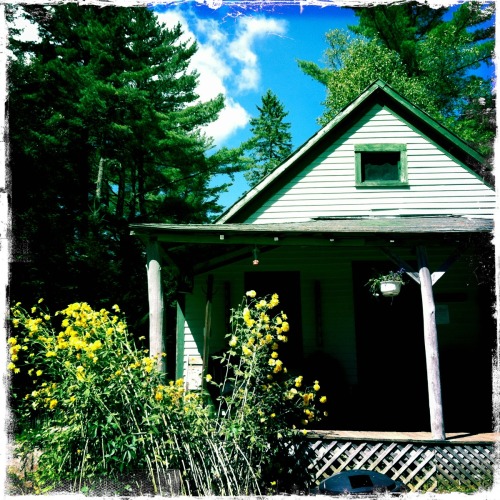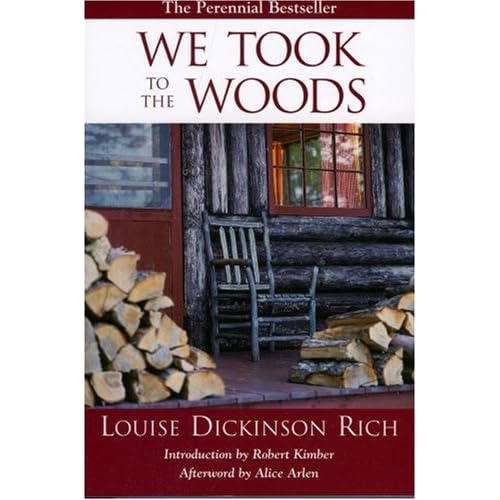
Louise Dickinson Rich
Louise Dickinson Rich was an iconic Maine writer. Born in Massachusetts in 1903, Louise Dickinson met her future husband, Ralph Rich, on a canoeing trip to the Rangeley area in western Maine in 1933. Ralph, and engineer and Louise, a teacher, were both fed up with everyday life and ended up falling in love and living together in a cabin in the woods of Forest Lodge, on the Rapid River.
Both of the Riches were skilled writers, but Louise found the most success. She began writing articles for numerous magazines, which were very lucrative in those days. With her writing income, she was able to help provide the basic necessities for her and Ralph’s growing family. The stories eventually morphed into books. Rich was a prolific writer and eventually authored 24 books and dozens of short stories and articles published in magazines.
Louise Dickinson Rich is best known for her popular book “We Took to the Woods” and its sequel, “My Neck of the Woods”, which told stories of the Riches’ life away from it all in the Maine woods. She wrote several historical books including “State o’ Maine”, and outdoor fiction for young adults, including “Start of the Trail”, an adventure story of a young Maine guide. She also had a “First Book” series, where she wrote historical books for young children. Rich’s life and writing are summarized in a biography written by Alice Arlen in 2000, entitled “She Took to the Woods”.
 |
The Winter House, where author Louise Dickinson Rich spent her winters, ovelooking Rapid River. Her books, which most of us in Western Maine read growing up, detail living in the Great North Woods.
In fact you still have to take a very bumpy, hour long, logging road route or go by boat then walk. I took a tour of the property earlier this month, as both houses are for sale and it is uncertain if future owners will preserve it in its current, museum-like state.
Winter House is small and snug and was created to withstand the fury of a Maine winter.
|
We Took To The Woods....
 |
The Winter House - where Maine author Louise Dickinson Rich wrote the bestseller "We Took to the Woods" in 1942 (Click on thumbnails photos below to enlarge).
|
Louise's typewriter
-
The 'Winter House"
"The cabin, hereafter to be referred to as the Winter House, was the original Forest Lodge, built for a fishing camp. It is a low building with a porch and an ell, set on a knoll with a view up the river to the Pond-in-the-River.” — "We Took to the Woods"

"It was a wonderful country, wild, dark, beautiful, remote and secret; rough, ruthless and demanding; and I loved it. Coming to it strange, I was immediately at home ... the place I slipped into as easily and naturally as a trout slips into a brook.dark, beautiful, remote and secret; rough, ruthless and demanding; and I loved it. Coming to it strange, I was immediately at home ... the place I slipped into as easily and naturally as a trout slips into a brook."
"I like to think of the lakes coming down from the north of us like a gigantic staircase to the sea. Kennebago to Rangeley to Cupsuptic, down they drop, level to level, through short, snarling rivers; Mooselukmeguntic to the Richardsons to Pond-in-the-River, and through Rapid River to Umbagog, whence they empty into the Androscoggin and begin the long south-easterly curve back to the ocean. I like to say their names, and I wish I could make you see them — long, lovely, lonely stretches of water, shut in by dark hills."
"One thing I know, one certainty cherish. [The woods] are still there, unchanged. The black tips of the spruces still stand motionless against an evening sky as they did when I was there to see, and the river roars with the same deep voice that filled the forest when I was there to hear. They are there. They will still be there if ever I need their strength and solace. "
(Louise Dickinson Rich)
http://outdoorsportinglibrary.com/?page_id=479
http://carolsavage.blogspot.com.es/2008/07/we-took-to-woods.html
http://new.yankeemagazine.com/article/when-louise-dickinson-rich-came-home-woods
http://lightandtexture.com/post/31330620776/the-winter-house-where-author-louise-dickinson












No hay comentarios:
Publicar un comentario